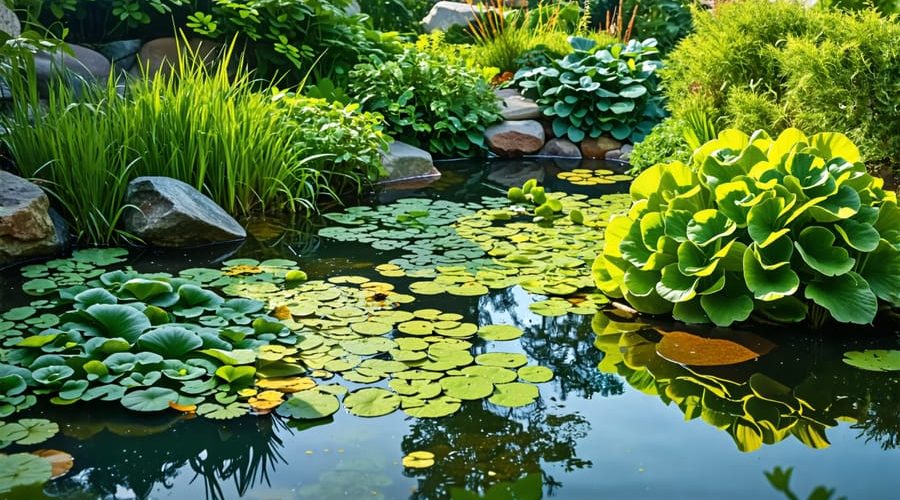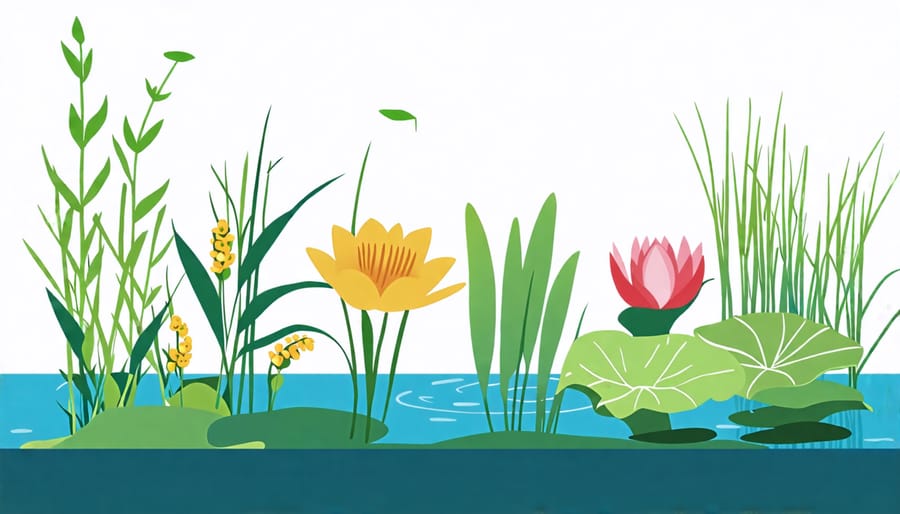
Crystal Clear Pond Secrets: Unleash the Power of Natural Filtration
Harness the power of nature to create a self-sustaining, crystal-clear pond with a natural filtration system. By mimicking the biological processes found in healthy ecosystems, you can establish a thriving aquatic environment that requires minimal maintenance. This comprehensive guide walks you through the essentials of designing, setting up, and maintaining a natural pond filter, empowering you to achieve a beautiful, balanced water feature in your own backyard.
Understanding the Basics of Natural Pond Filtration
The Role of Plants
Aquatic plants are the unsung heroes of natural pond filtration systems. These green wonders act as living filters, absorbing excess nutrients like nitrates and phosphates that can fuel algae growth and cloud the water. As they take in these nutrients, aquatic plants incorporate them into their own growth, effectively removing them from the water column. Moreover, during photosynthesis, these plants release oxygen into the pond, creating a healthier environment for fish and beneficial bacteria. Submerged plants like hornwort and anacharis are particularly efficient at oxygenating the water, while floating plants such as water lettuce and water hyacinth excel at nutrient uptake. By incorporating a diverse array of aquatic plants into your pond, you harness the power of nature to maintain crystal-clear water and a thriving ecosystem. Embrace the beauty and function of aquatic plants, and watch your pond transform into a self-sustaining oasis.
Beneficial Bacteria: The Unsung Heroes
Beneficial bacteria are the unsung heroes of your natural pond filtration system. These microscopic marvels work tirelessly to break down organic waste, such as fish excrement, decaying plant matter, and excess nutrients. As they consume and process this waste, beneficial bacteria help maintain water clarity and prevent the buildup of harmful substances like ammonia and nitrites.
Without these tiny allies, your pond would quickly become murky and unhealthy. Beneficial bacteria form the foundation of a thriving ecosystem, supporting the well-being of your fish, plants, and other aquatic life. By creating a balanced environment, they minimize the need for frequent water changes and chemical treatments.
To cultivate a robust population of beneficial bacteria, provide ample surface area for them to colonize, such as bio-media in your filtration system or porous rocks and gravel. Regularly monitor water parameters and avoid overfeeding your fish to maintain an optimal balance of nutrients for these hardworking microorganisms.
Creating a Balanced Ecosystem
Creating a balanced ecosystem is crucial for the success of your natural pond filtration system. Plants, bacteria, and other pond inhabitants work together to maintain crystal-clear water and a healthy environment. Aquatic plants absorb excess nutrients, preventing algae growth, while beneficial bacteria break down organic waste. Fish and other aquatic creatures contribute to the ecosystem by eating algae and insects. Striking the right balance between these elements ensures a self-sustaining, low-maintenance pond. Experiment with different plant species, fish populations, and water features to find the perfect harmony for your unique pond setup. With patience and careful observation, you’ll soon achieve a thriving, naturally filtered oasis in your backyard.

Designing Your Natural Pond Filtration System
Choosing the Right Plants
When selecting plants for your natural pond filtration system, consider a mix of submerged, marginal, and floating plants. Best aquatic plants for filtration include hornwort, water lettuce, and water hyacinth, which absorb excess nutrients and provide shade. Submerged plants like anacharis and vallisneria oxygenate the water and compete with algae for nutrients. Marginal plants such as cattails, rushes, and irises help stabilize the pond edges and filter water as it enters.
Choose plants based on your pond’s size, depth, and climate. Larger ponds can support more diverse plant life, while smaller ponds may require careful selection to avoid overcrowding. Consider your hardiness zone when choosing plants to ensure they can withstand your local climate. Aim for a mix of native and non-invasive species to create a balanced ecosystem.
Start with a few key species and gradually add more as your pond matures. Be mindful of each plant’s growth habits and potential to spread, as some may require regular pruning to maintain a healthy balance. With the right combination of aquatic plants, your natural pond filtration system will create a beautiful and thriving environment for years to come.
Optimal Plant Placement
When placing plants in your pond for optimal filtration, consider creating different zones based on water depth. Position marginal plants like cattails and rushes along the shallow edges where they can absorb excess nutrients. Submerged plants such as hornwort and anacharis should be placed in the deeper areas to oxygenate the water and provide hiding spots for beneficial bacteria. Floating plants like water lettuce and water hyacinth can be dispersed across the surface to shade the pond and prevent algae growth. Experiment with various arrangements to find the perfect balance for your pond’s ecosystem, ensuring adequate circulation and avoiding overcrowding.

Incorporating Mechanical Filtration
For optimal pond clarity and health, combining natural filtration with mechanical filters can be highly effective. While natural filters like plants and bacteria work to break down organic matter and nutrients, mechanical filters help remove physical debris and particulates from the water.
Installing a mechanical filter, such as a skimmer or pump-powered filter, complements your natural filtration system by trapping leaves, twigs, and other solid waste before it sinks and decomposes. This helps reduce the load on your natural filters, allowing them to work more efficiently.
When choosing a mechanical filter, consider the size of your pond and the type of debris you typically encounter. Skimmers are great for surface debris, while submersible filters target particulates throughout the water column. Look for filters with easy-to-clean screens or baskets to simplify maintenance.
Positioning your mechanical filter near your pond’s edge or in an area with good water circulation will ensure it can effectively capture debris. Regular cleaning, usually every few weeks, will keep your filter functioning optimally and prevent clogs.
By incorporating mechanical filtration alongside your natural filters, you’ll create a comprehensive system that keeps your pond water crystal clear and your aquatic ecosystem thriving. Experiment with different setups to find the perfect balance for your unique pond environment.
Maintaining Your Natural Filtration System

Regular Pond Maintenance
To keep your natural pond filtration system running smoothly, establish a regular maintenance schedule. Weekly tasks include skimming debris from the water surface, checking water levels, and inspecting the pump and filters for clogs. Each month, trim aquatic plants to prevent overgrowth and remove any dead foliage. Test the water quality monthly using pond test kits, monitoring pH, ammonia, nitrite, and nitrate levels. Adjust as needed by performing partial water changes or adding beneficial bacteria. Seasonally, clean the pump and filters thoroughly, divide and repot overcrowded plants, and add fresh mulch to bog areas. In fall, net the pond to catch falling leaves. Winter preparation involves cutting back dormant plants and ensuring proper water circulation to maintain oxygenation. Stay proactive with pond maintenance to enjoy a thriving, low-maintenance ecosystem that naturally filters your water garden.
Troubleshooting Common Issues
Even with a well-designed natural filtration system, issues may occasionally arise. If you notice cloudy water, check for excess debris and remove it promptly. Algae blooms can be controlled by adding more aquatic plants to absorb nutrients and limiting direct sunlight. If water flow seems sluggish, inspect your pump and clear any blockages. Regularly trim plants to prevent overgrowth and maintain balanced filtration. Should your pond develop an unpleasant odor, consider adding beneficial bacteria to break down organic matter more efficiently. Monitoring water quality with test kits can help identify imbalances early on. If fish appear stressed or unhealthy, assess the water parameters and make gradual adjustments as needed. Remember, patience is key when troubleshooting natural filtration systems. Allow time for the ecosystem to rebalance after making changes, and don’t hesitate to seek advice from experienced pond enthusiasts if challenges persist. With attentive care and a bit of trial and error, you’ll keep your pond’s natural filtration system thriving.
Conclusion
A natural pond filtration system offers an eco-friendly, low-maintenance solution for keeping your water garden crystal clear and healthy. By harnessing the power of plants, beneficial bacteria, and natural processes, you can create a self-sustaining ecosystem that supports a thriving aquatic environment. Not only does this approach minimize the need for chemical treatments and frequent cleaning, but it also enhances the overall beauty and biodiversity of your pond. With a little patience and the right setup, you can enjoy the tranquility of a naturally filtered pond that attracts wildlife and provides a serene escape in your own backyard. So, embrace the wonders of nature and give your pond the gift of a natural filtration system – your fish, plants, and peace of mind will thank you!
